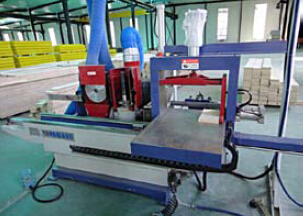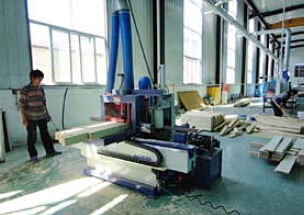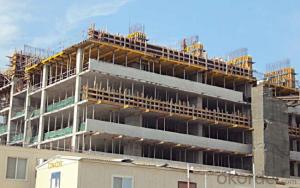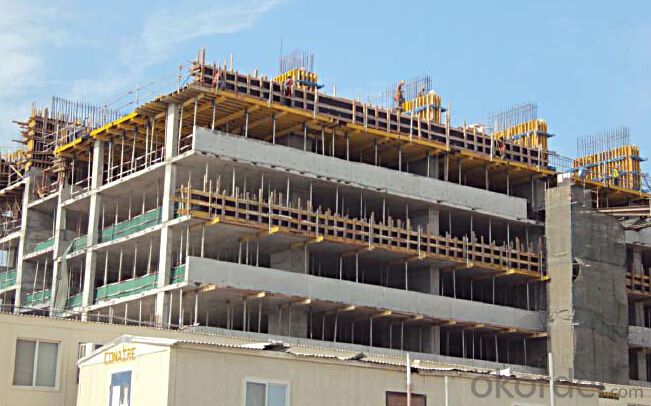Timber Beam Formwork H20 for formwork and scaffolding systems
- Loading Port:
- Tianjin
- Payment Terms:
- TT OR LC
- Min Order Qty:
- 50 m²
- Supply Capability:
- 1000 m²/month
OKorder Service Pledge
OKorder Financial Service
You Might Also Like
Characteristics:
◆ Standardized production lines.
Supply capability: 3000m/day, Lmax = 6600mm.
◆ Finger jointing of the flange and web, the strength of timber beam is highly improved.
Max. shearing force failure load:40KN
◆ Well treated to prevent from water penetration or erosion, so the service life maximally
extended.
Normally, CNBM timber beam H20 can be used for 4 to 5 years, the exact using time would
depend on maintenance & storage.
◆ Robust caps at the end of the girders protect against damages.




- Q: What are the maintenance requirements for steel formwork?
- The maintenance requirements for steel formwork primarily involve regular cleaning and inspection. Firstly, it is essential to clean the steel formwork after each use to remove any concrete residue, dirt, or debris. This can be done by using water and a mild detergent, or alternatively, a high-pressure washer can be used for more stubborn stains. Additionally, it is crucial to inspect the steel formwork for any signs of wear, damage, or corrosion. This should be done before and after each use to ensure its structural integrity. Any rust or corrosion spots should be treated promptly by cleaning, sanding, and applying a rust inhibitor or paint to prevent further deterioration. Furthermore, the joints, connections, and fasteners of the steel formwork should be regularly checked to ensure tightness and proper functioning. Loose or damaged parts should be repaired or replaced as necessary. Storage is another important aspect of maintenance. Steel formwork should be stored in a dry and well-ventilated area to prevent rusting and corrosion. It is advisable to stack the formwork properly, with adequate spacing between each piece to prevent deformation and facilitate air circulation. Lastly, it is essential to follow the manufacturer's instructions and recommendations for maintenance and care. This includes using the formwork within its load-bearing capacity, avoiding excessive impact or rough handling, and adhering to any specific maintenance guidelines provided. By following these maintenance requirements, steel formwork can be kept in optimal condition, ensuring its durability, reliability, and longevity for future construction projects.
- Q: How does steel formwork handle different concrete curing methods?
- Steel formwork is known for its durability and flexibility, which makes it suitable for handling different concrete curing methods. The strength and stability of steel formwork enable it to withstand the pressure exerted by different curing methods, ensuring that the formwork remains intact throughout the process. One common concrete curing method is the traditional wet curing method, where the concrete is kept moist by covering it with plastic sheets or wet burlap. Steel formwork can easily accommodate this method as it is non-absorbent and resistant to moisture. It effectively prevents water from seeping into the formwork, ensuring its longevity and structural integrity. Another curing method is the use of curing compounds or curing membranes that are applied to the concrete surface. These compounds create a barrier that prevents the moisture from evaporating too quickly, allowing the concrete to cure at a controlled pace. Steel formwork is compatible with curing compounds and membranes, as they can be easily applied and adhered to the surface of the formwork without causing any damage. Additionally, steel formwork can also handle the use of accelerated curing methods, such as the application of heat or steam to speed up the curing process. The high strength and heat resistance of steel allow it to withstand the elevated temperatures generated during accelerated curing without warping or deforming. This ensures that the formwork maintains its shape and stability, even under extreme conditions. In summary, steel formwork is well-suited to handle different concrete curing methods due to its durability, moisture resistance, and heat resistance. Its ability to withstand the pressures and conditions associated with various curing techniques makes it a reliable choice for construction projects that require versatile and robust formwork systems.
- Q: What are the different sizes and dimensions of steel formwork panels?
- Steel formwork panels come in various sizes and dimensions to cater to different construction needs. The sizes and dimensions of steel formwork panels can vary depending on the manufacturer and the specific requirements of a project. However, there are some common sizes and dimensions that are widely available in the market. The standard dimensions of steel formwork panels usually range from 1.2 meters to 2.4 meters in length and 0.6 meters to 1.2 meters in width. These standard sizes are designed to be easily handled and transported on construction sites. Additionally, the thickness of steel formwork panels can vary between 3 millimeters to 6 millimeters, depending on the load-bearing capacity required. Apart from the standard sizes, custom sizes can also be manufactured to meet specific project needs. These custom sizes can be larger or smaller than the standard dimensions, depending on the complexity and scale of the construction project. In terms of weight, steel formwork panels are relatively heavy due to the material's durability and strength. The weight of a steel formwork panel can range from 30 kilograms to 50 kilograms, depending on its size and thickness. Overall, the sizes and dimensions of steel formwork panels can vary to accommodate different construction requirements. It is important to consult with a supplier or manufacturer to determine the most suitable size and dimension for a specific project.
- Q: What type of concrete finishes can be achieved with steel formwork?
- Steel formwork offers a multitude of possibilities for achieving various concrete finishes. A popular choice is a smooth and level surface, which can be accomplished by using steel formwork with a sleek texture. This finish is well-suited for areas that necessitate an even and flat surface, such as floors and walls. Another option is to achieve a textured or patterned surface using steel formwork. This can be done by utilizing formwork with a textured or patterned surface itself, or by incorporating additional materials like rubber or plastic liners to create the desired texture or pattern. This finish is often employed for decorative purposes, such as architectural concrete elements or exposed aggregate finishes. Furthermore, steel formwork allows for the creation of curved or shaped concrete surfaces. This involves bending or shaping the formwork prior to pouring the concrete, resulting in unique and visually pleasing shapes. This type of finish is commonly used in architectural or artistic applications. Ultimately, steel formwork provides a versatile solution for achieving a diverse range of concrete finishes, including smooth, textured, patterned, and curved surfaces. The choice of finish depends on the specific requirements and desired aesthetics of the project.
- Q: What are the different types of steel formwork accessories available?
- There are several different types of steel formwork accessories available in the market. These accessories are designed to enhance the efficiency and effectiveness of steel formwork systems and make the construction process smoother. Some of the common types of steel formwork accessories include: 1. Formwork clamps: These clamps are used to secure the formwork panels together, ensuring stability and preventing any movement during the concrete pouring process. They come in various sizes and shapes to fit different formwork systems. 2. Formwork ties: These are used to hold the formwork panels together and provide additional support. Formwork ties are available in different lengths and materials to accommodate various formwork requirements. 3. Formwork connectors: These connectors are used to join the formwork panels at corners or intersections. They provide a strong and secure connection, ensuring proper alignment and stability of the formwork system. 4. Formwork wedges: These wedges are used to adjust the formwork panels and provide the desired level of inclination or angle. They are typically made of steel and can be easily inserted or removed to achieve the desired formwork configuration. 5. Formwork brackets: These brackets are used to support the formwork panels vertically or horizontally. They are adjustable and can be easily installed or removed to accommodate different formwork configurations. 6. Formwork spacers: These spacers are used to maintain a specific spacing between the formwork panels. They ensure consistent concrete thickness and prevent any bulging or deformation during the pouring process. 7. Formwork props: These props are used to support the formwork system and provide additional stability. They are adjustable in height and can be easily installed or removed as required. 8. Formwork anchors: These anchors are used to secure the formwork system to the ground or the existing structure. They provide stability and prevent any movement during the concrete pouring and curing process. Overall, these steel formwork accessories play a crucial role in ensuring the structural integrity and stability of the formwork system. They are designed to withstand high pressure and provide a reliable and efficient solution for construction projects.
- Q: Can steel formwork be used for structures with high wind resistance requirements?
- Indeed, structures with high wind resistance requirements can make use of steel formwork. The robustness and durability of steel enables it to endure the pressures imposed by strong winds. When employed as formwork, steel furnishes a reliable and inflexible framework for pouring concrete, guaranteeing that the structure preserves its form and steadfastness, even amidst exceedingly turbulent wind circumstances. Furthermore, steel formwork can be tailored and fortified to comply with precise wind load specifications, rendering it apt for erecting buildings in regions susceptible to fierce winds or hurricanes.
- Q: How does steel formwork handle complex geometries?
- Construction projects can easily manage complex geometries using steel formwork, which is known for its versatility. Unlike traditional wooden formwork, steel formwork is custom-made to fit the project's specific requirements, allowing for the creation of intricate and complex shapes. Modular components are used to construct steel formwork, which can be assembled and adjusted to accommodate various geometric configurations. This flexibility enables it to handle challenging shapes like curves, arches, and irregular structures, which would be difficult to achieve with other types of formwork. In addition, steel formwork offers superior strength and stability, allowing it to withstand the pressure exerted by the concrete during pouring and curing. This strength enables the construction of tall and complex structures without compromising the integrity of the formwork system. Furthermore, steel formwork can be easily reused multiple times, making it a cost-effective solution for managing complex geometries. Its durability and resistance to wear and tear ensure that it can be used for numerous projects, further enhancing its economic viability. Moreover, steel formwork provides a smooth and consistent finish to the concrete surface, resulting in high-quality end products. This is especially important when dealing with complex geometries, as any imperfections or inconsistencies could be more noticeable. In conclusion, steel formwork is a reliable and efficient solution for managing complex geometries in construction. Its versatility, strength, reusability, and ability to provide a smooth finish make it an ideal choice for projects with intricate and challenging shapes.
- Q: What are the typical lead times for manufacturing steel formwork?
- The typical lead times for manufacturing steel formwork can vary depending on factors such as the complexity of the design, the quantity required, and the current workload of the manufacturer. However, on average, lead times for manufacturing steel formwork can range from a few weeks to a few months.
- Q: Can steel formwork be used in seismic zones?
- Yes, steel formwork can be used in seismic zones. Steel is a strong and durable material that can withstand the forces exerted during an earthquake. It has the ability to flex and absorb energy, making it suitable for use in seismic zones. Additionally, steel formwork provides stability and rigidity to the structure, ensuring that it can withstand the shaking and movement caused by seismic activity. However, it is important to consider other factors such as design, construction techniques, and local building codes to ensure that the steel formwork system is properly installed and meets the specific requirements of the seismic zone.
- Q: Can steel formwork be used for both horizontal and vertical concrete elements?
- Yes, steel formwork can be used for both horizontal and vertical concrete elements. Steel formwork provides strength, stability, and durability, making it suitable for a wide range of construction projects. Its versatility allows for the creation of various shapes and sizes, making it a preferred choice for both horizontal slabs and vertical walls.
Send your message to us
Timber Beam Formwork H20 for formwork and scaffolding systems
- Loading Port:
- Tianjin
- Payment Terms:
- TT OR LC
- Min Order Qty:
- 50 m²
- Supply Capability:
- 1000 m²/month
OKorder Service Pledge
OKorder Financial Service
Similar products
Hot products
Hot Searches
Related keywords



















